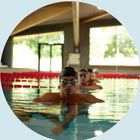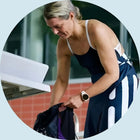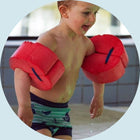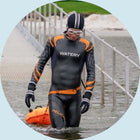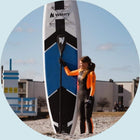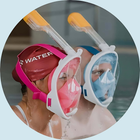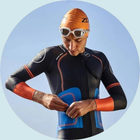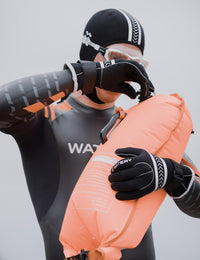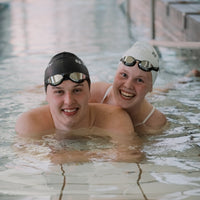Read more about the many swimming tips below.
Safety rules
Rules are important to increase safety. That's why there are a number of swimming tips created by the Irish Council for Greater Bathing Safety to create more respect for water. Below, you can read about the different swimming tips and what to do in the event of an accident.
Follow the five tips for safe bathing
Bathing rules have changed over the years, but they're basically always the same. Even though they are called swimming advice, they should be seen as beach rules of the road. To ensure that you or others are safe when swimming, it's significant to follow the advice to the best of your ability. Most drowning accidents could have been avoided if the swimming advice had been followed. Below, you can read more about each swimming advice.
-
Learn to swim
Being able to swim is incredibly significant for staying safe around water. If you can swim, you can save yourself and others from drowning. If you can't swim or don't feel like you're a strong swimmer, find a place with calm water conditions. It's important that you can swim to the bottom.
-
Never go into the water alone
If you go into the water alone, it can be difficult to get the help you need if you need it. If there are many of you in the water, you can react quickly and help each other if something goes wrong. It's significant to keep an eye on each other - even if you can swim. To maximize safety, avoid playing dangerous games or shouting for help for fun.
-
Get to know the beach
If you swim at a new beach that you don't know, it can hide a lot of surprises that can lead to dangerous situations. To avoid surprises, it's a good idea to get to know the beach. You can go swimming with someone who knows the beach, or ask locals or a lifeguard. This way you can quickly learn about the depth of the beach, waves, substrate, current, etc.
If you're swimming abroad, it's important that you also familiarize yourself with different animals or reefs that can be dangerous. A good way to familiarize yourself with a beach is to read and watch the beach information signs.
Finally, you should be aware if you visit a beach that uses beach flags. Keep an eye on which flags are up and ask if you don't know what they mean.
-
Read the wind and weather
Before you jump in the water, it's always a good idea to check the weather forecast. You can't always count on the beach behaving the same way it did the last time you went swimming. Always listen to your common sense. If something feels strange or different, it's better to get out than stay in the water.
If there's a lot of wind, your water toy or inflatable can easily float towards the open sea. In addition, there is also a greater risk of firefighters in offshore winds. If there is an onshore wind, there is a risk of rip holes.
-
Don't let the kids out of your sight
Kids are not as good at judging situations as an adult. That's why it's important that kids never swim unsupervised. When swimming with kids, it's significant that you always keep an eye on them so that you can get to them as quickly as possible if something goes wrong.
Even if you have older kids who are strong swimmers, it's significant to remember that the sea is very different from the swimming pool. The ocean harbours currents and waves that can pull a swimmer further out.
Other tips and tricks
The 5 swimming tips are designed to create more respect for water. The advice has been developed by the Irish Council for Greater Bathing Safety to raise awareness of how to swim safely in the summer. The 5 swimming tips will take you a long way, but there are several things to keep in mind when you go swimming.
Only bathe where permitted
When the weather is nice, many people want to take a refreshing dip. If you arrive at a crowded beach, someone will often try to find a quieter spot. This can drive people away from the places where swimming is allowed to find a place without so many people.
Even if there are a lot of people, it's better to swim where it's allowed than anywhere else. In Ireland, you can swim at most places along the coast - and the coast is something Ireland has a lot of. You can also swim at private beaches.

If you live near a publicly owned lake, you are allowed to swim there around the clock - unless otherwise signposted. It's still important to follow the 5 swimming rules, even if the lake looks calm.
If you live near a privately owned lake, you can only swim there if there are multiple owners, unless there are signs saying otherwise.
You can also swim in a harbour bath if you live in big cities. Here, a bathing facility is located in the harbour, where there are jetties, lifesaving equipment and no boat danger.
Don't swim here
When swimming at a private beach or a privately owned lake, there are some rules you need to take into account.
At a privately owned lake, it must be possible to access the lake by roads or paths. In addition, if the lake is located in a forest, it must also be at least 150 metres from the nearest residential area. At a private beach, there must be at least 50 metres to a dwelling.
Do not swim in smaller marshes or small lakes where the water is calm most of the time. This is because the water is very cold below the surface, which cools your body quickly.
Get up when you start to freeze
Don't underestimate the cold when swimming. It takes a long time for the water to warm up in Ireland, and we often swim in cold water. It can be super refreshing to swim in cold water when the weather is warm, but remember to get up early.
Only jump upside down where the water is deep enough
Jumping into water is super cool. You don't have to convince yourself to go under if the water is a bit cold at first. Instead, you just jump in and quickly get used to the water.
Another advantage of jumping is that you can do it from jetties. This means you don't have to go into the water, where there's typically a lot of seaweed if you're swimming at a beach.
While jumping is great, it's important to do it right. If you don't think beforehand, a jump can quickly cause injury. If you jump upside down, it's significant that the water is deep enough. If the water isn't deep enough, you could hit your head on the bottom.
Swim along the coast
When you're swimming at a beach, it can be great to get out far and wide. When you head out to sea, it's significant that you can swim to the bottom so you can easily get back to the beach.
If you want to swim, it's better to swim along the shore. That way, you'll be sure you can get back to the beach more easily if you get tired. If you're swimming out to sea, remember that you should also be able to get back to the beach before you get tired.
Don't swim with alcohol in your blood
Young people in particular enjoy meeting on the beach. Many people meet up for barbecues on the beach, and a beer or two can be drunk. You can rarely feel how intoxicated you are, so a good swimming tip is not to swim or swim with alcohol in your blood.
If you swim drunk, you won't pay as much attention to the beach or others. If the others are also drinking, there's no one to keep an eye on you either.
First aid and defibrillator - How to
If an accident does happen, it's important to help as soon as possible. The first thing you should do if you see someone drowning is to get them to shore. You can't help them in the water, and you could get yourself into trouble. If you pull them to shore, you can help them better and more safely.
Below, you can read how to give first aid.
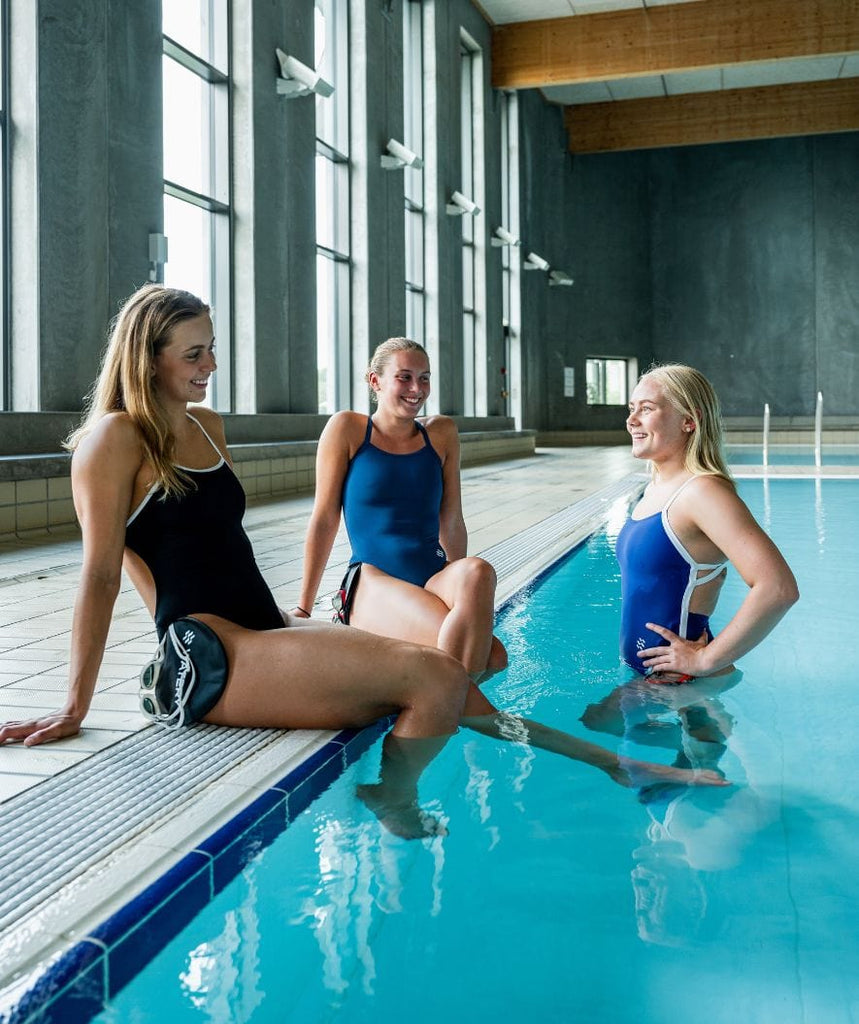
How to perform first aid on the unconscious
The first thing you need to do is assess the person. Even if the person seems unconscious, it's important that you try to wake them up. Start by shaking their shoulders and talking to them loudly and clearly. If they are unconscious, they won't respond.
If they are unconscious, it's significant to check their breathing. You can do this by using the ABC principle:
A: Airway
Here you need to assess if there is a clear airway. If the person is talking, the airway is clear. If the person is snoring, wheezing or gasping for air, the airway is not clear. To best check the airway, pull their chin up. Airways can also be blocked even in cases of drowning. In this case, it could be the person's own tongue that is blocking the airway. If it's their tongue that's in the way, you can help them by creating a clear airway.
To do this, place one hand on their forehead and the other under their chin. Then you can pull their chin up while keeping their forehead down.
B: Breathing
Even if the airway is clear, there may still be reasons why the person is not breathing normally. Normal adult breathing is around 12-15 times per minute. If it's normal, it should be silent and effortless.
If breathing is not sufficient, it can be seen as a bluish tinge on the skin, mouth and lips, among other things. You can check breathing by listening, looking and feeling.
You can place your ear next to their mouth and nose while looking down at their chest. This way, you'll be able to both feel and hear the breathing in your ear, and you'll be able to see their chest rise and fall as they breathe. Don't spend too much time doing this, as you need to call 1-1-2 as soon as possible if breathing is not normal.
C: Circulation
You can also get hurt in the water. If they've cut themselves on rocks or perhaps jumped upside down in water that wasn't deep enough. Either way, you should also check their blood circulation.
You start by looking for visible haemorrhages. You should also look for pale, cold and moist skin. If the brain isn't getting enough blood, the person will typically be dazed or unconscious.
If the injured person is breathing normally, place them in a stable lateral position. You can do this with these 5 steps:
- First, kneel down next to the person. Then place the arm closest to you at a right angle to the person's body with your palm facing up
- Bend the person's other arm over their upper body. Here, place the back of your hand against the cheek closest to you
- Bend the furthest leg while holding their hand against their cheek. Once the leg is bent, you can use it to roll them into a stable lateral position
- Then you can adjust the side position so that their hips and legs are bent at 90 degrees
- Keep their head upright so there is a clear airway. Remember to continue to monitor their breathing. If it worsens or stops, consider starting CPR
When the person is in a stable lateral position, their airway will be kept clear, even if they may vomit.
If there is no normal breathing, you should
Start CPR, which stands for cardiopulmonary resuscitation. When the person is unconscious and not breathing, it means they are in cardiac arrest. It's important that you or someone else calls 1-1-2 and begins CPR as soon as possible.
You administer CPR in the following way:
- Press the centre of your chest. To do this, place the root of your hand in the centre of your chest and place your other hand on top. To make your hands more stable, intertwine your fingers
- Press down about 5-6 cm at a pace of around 100-120 presses per minute. If you're unsure if your rhythm is right, you can follow Bee Gee's Staying Alive
- When tapping, lean in over the person and tap with outstretched arms
- After you have pressed 30 times, give 2 blasts
- First, create a clear airway by bending the person's head backwards
- Place one hand on the person's forehead and pinch their nostrils together with your index finger and thumb
- Use the other hand to hold the chin-up so that the person's mouth is open
- When giving breaths, take a normal breath and place your mouth around the person's mouth
- Then breathe in until you can see your chest rise
- Once you have breathed in 2 times, give 30 pressures again. Repeat this until help arrives
In the case of drowning, you should not pay attention to water in the lungs when giving CPR. The amount of water that the person could have swallowed is not enough to prevent you from giving CPR. If there are several of you present, it is recommended that you take turns performing CPR.
Performing CPR is scary, but it's life-saving for the person. The only thing you can do wrong is to do nothing. You'd rather break one of their ribs than watch them die.
How a defibrillator works
When you call the emergency centre, they will typically tell you whether to run towards an AED. If there are several of you, one of you will typically be asked to run towards a defibrillator. When you reach the defibrillator, a voice will tell you what to do.
Below, you can read how to use an AED (defibrillator)
- Keep giving CPR until the AED arrives
- Switch on the defibrillator immediately
- Listen to the voice and follow it to the best of your ability
- Place the pads when the AED tells you to
- Remove the clothing from your chest and place the electrodes in the locations shown on the defibrillator
- Make sure no one is touching the person when the AED is shocking and analysing
- If the AED prompts you to continue CPR, start again without removing the pads
- If your CPR is working and the person starts breathing, place them in a stable lateral position
How to call for help
When an accident happens, it is important that you call for help as soon as possible. When you call 1-1-2, it's significant that you speak clearly and concisely. Tell them what has happened and where you are. Follow the instructions as closely as possible and answer questions as best you can.
When you call the emergency call centre, they are the ones who end the call. This way you can make sure they get all the information, and you can get updates on how far away help is.
If you don't know where you are, you can use your GPS or the 112 app, which sends your coordinates directly to the emergency services.
